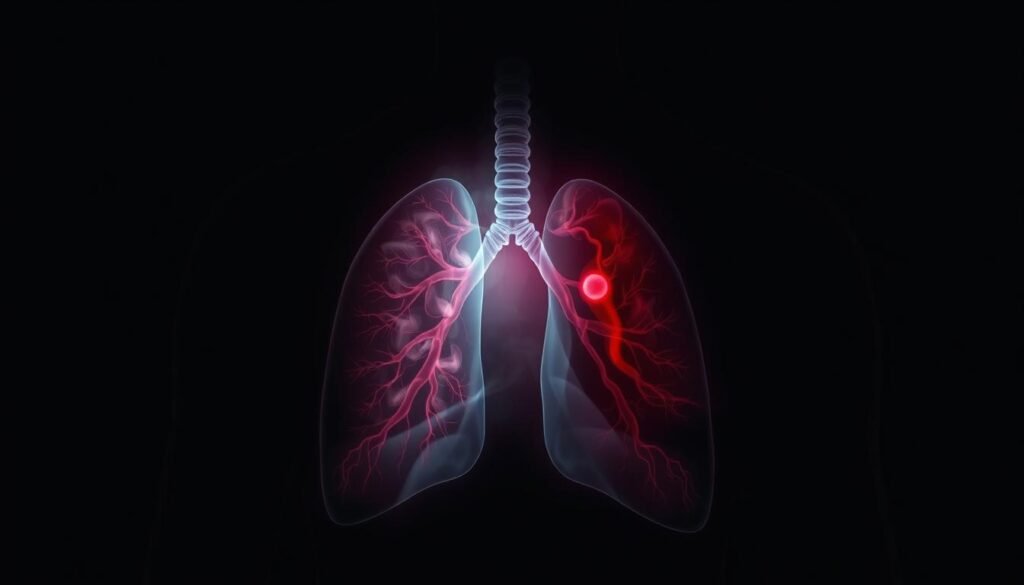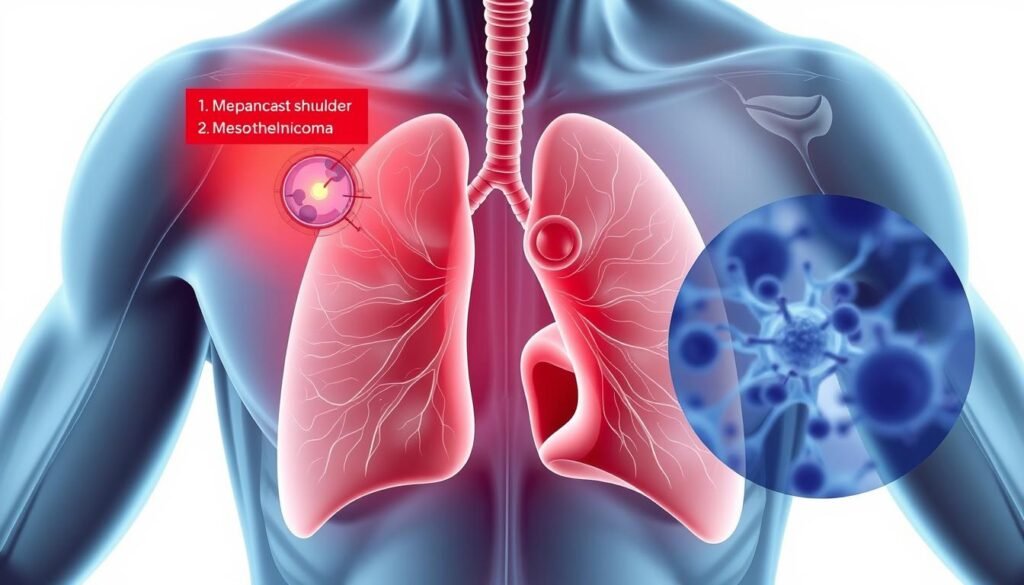About 30% to 40% of people with lung cancer develop bone metastases. This fact underscores the need for awareness about symptoms like shoulder blade pain. Often, we may think shoulder pain is just from a stiff muscle or arthritis. Yet, it could be a signal of lung cancer. Recognizing this could help catch the disease early, making treatment more effective.
Paying attention to shoulder pain is becoming crucial for both doctors and patients. Since lung cancer is only spotted on 25% of chest X-rays, other signs like shoulder pain need careful consideration. Knowing how shoulder pain connects to lung cancer is key to catching it early.
Key Takeaways
- Bone metastases occur in 30% to 40% of lung cancer cases, notably affecting the spine.
- Shoulder pain can be an early symptom of malignant pleural mesothelioma in some patients.
- Pancoast tumors, although rare, make up 3%-5% of lung cancer cases and can be particularly elusive to diagnose.
- Awareness of lung cancer signs is essential as they can vary widely.
- Recent guidelines aim to improve the recognition of lung cancer as a potential cause of shoulder pain.
- Misdiagnosis is common, with up to 25% of lung cancers missed on initial chest X-rays.
Understanding Lung Cancer and Its Symptoms
Lung cancer is a major health issue, often caught too late. Spotting symptoms early is key to better outcomes. Many sufferers show symptoms that look like other health problems. This makes knowing about them important for early action.
Overview of Lung Cancer
Lung cancer is the top cause of cancer deaths in the US. There are two main kinds: non-small cell and small cell lung cancer. Each has different signs. Knowing these helps catch the disease early.
Common Symptoms of Lung Cancer
Important symptoms of lung cancer include:
- Chronic cough that gets worse with time
- Unexplained weight loss, more than 5% quickly
- Tiredness that rest doesn’t fix
- Shortness of breath that changes in intensity
- Hoarseness in the voice from nerve pressure
- Coughing up blood, seen in about 20% of patients
Around 50% of those affected will have a persistent cough. Up to 75% may lose a lot of weight without trying before they’re diagnosed. While other conditions can cause these, they might also mean lung cancer.
Lung cancer can cause shoulder pain, especially with Pancoast tumors. These grow in the lung’s top part, pressing on nearby areas. This leads to pain in the shoulder blade. Spotting these signs early is vital for getting the right medical help.
| Symptom | Prevalence |
|---|---|
| Persistent Cough | 50% |
| Unintentional Weight Loss | 35-75% |
| Coughing Up Blood | 20% |
| Tiredness/Fatigue | Varies |
| Shortness of Breath | Common |
It’s critical to know the symptoms of both non-small cell and small cell lung cancer. Recognizing these signs early can lead to quick diagnosis and treatment. This greatly improves the chances for people facing this dangerous disease.
What is Shoulder Blade Pain?
Shoulder blade pain comes from different causes and injuries. It’s key to know why it happens to manage it. Muscle strains, too much use, or direct injuries can cause discomfort around the shoulder blade. Issues like tendinitis and bursitis might also lead to pain. While mild pain is usually not worrisome, some symptoms need more attention.
Causes of Shoulder Blade Pain
Several conditions can lead to shoulder blade pain. Muscle problems, such as strains or tears, can be painful. Bones and joints issues, like osteoarthritis or spinal stenosis, can impact the shoulder too. Moreover, severe underlying health problems could show up as shoulder pain. For example, back pain from lung cancer can occur, showing the importance of being aware.
When is Shoulder Pain a Concern?
It’s vital to know when shoulder pain could signal serious health issues. Severe pain, or pain with symptoms like shortness of breath, chest pain, or fatigue, needs a doctor’s attention. While minor pain is common, ongoing discomfort could indicate a bigger problem, such as lung cancer. Shoulder pain linked to lung cancer is especially crucial to check if the pain’s nature changes.

| Condition | Symptoms | Treatment Options |
|---|---|---|
| Muscle Strain | Pain, weakness, reduced range of motion | Rest, physical therapy, pain relievers |
| Osteoarthritis | Joint stiffness, swelling, pain | Medications, physical therapy, lifestyle changes |
| Pancoast Tumor | Severe shoulder blade pain, lung-related symptoms | Chemotherapy, radiation, surgery |
| Heart Problems | Chest pain, discomfort in shoulder, shortness of breath | Emergency medical attention, medications, lifestyle modification |
Symptoms Lung Cancer Shoulder Blade Pain
Shoulder blade pain often causes worry. It makes people think about its link to serious health problems. Lung cancer can lead to this kind of pain. It’s known as referred pain from lung cancer. This happens when the pain in the lungs moves to the shoulder area. It’s more common with certain kinds of tumors, like Pancoast tumors.
Is Shoulder Blade Pain Related to Lung Cancer?
Shoulder blade pain can be a sign of different health issues, including lung cancer. In the later stages of lung cancer, symptoms get clearer. Referred pain is one of these symptoms. This cancer can affect the tissues and nerves around it. This causes pain that spreads to other areas, not just the chest. If you have shoulder pain that stays, especially if you also have trouble breathing, it’s important to see a doctor.
Other Symptoms that Accompany Shoulder Pain
Apart from shoulder blade pain, there are other signs that might suggest lung cancer. These include:
- Chronic cough or changes in how you cough
- Weight loss that you can’t explain
- Feeling tired even after resting
- Having trouble catching your breath or wheezing
- Chest pain that spreads
Noticing these signs early is really important for treatment. Paying attention to shoulder pain with breathing problems can help find lung cancer sooner. If you have these signs, it’s a good idea to talk to a doctor. They might do tests like scans to find out why you’re in pain. For more info on lung cancer symptoms, check out this page.

Types of Lung Cancer that Cause Shoulder Pain
It’s important to know about lung cancers that lead to shoulder pain for early care. Pancoast tumor and mesothelioma are such cancers. They bring symptoms that greatly affect life.
Pancoast Tumor: A Unique Cancer Type
Only 3-5% of lung cancer cases are Pancoast tumors. They grow at the top of the lungs. These cause shoulder pain as a first sign for almost all patients.
The pain can also move down the arm. This might make people think the problem is not cancer but something less serious. Pancoast tumors are mostly non-small cell lung cancer. Adenocarcinomas are the most common ones.
The treatment changes based on how far the cancer has spread and the patient’s health. Sometimes, surgery might remove part of the ribs or major blood vessels. Often, doctors use chemoradiotherapy before surgery to shrink the tumor. After, immunotherapy might help fight the cancer cells.
Mesothelioma and Its Symptoms
Mesothelioma, a cancer from asbestos exposure, also causes symptoms like lung cancer. It mainly affects breathing. A study showed mesothelioma patients rate their shoulder pain as 4 out of 10. For 14% of them, it was the first warning sign.
Diagnosing it is tough because its symptoms overlap with other illnesses, like arthritis. Quick diagnosis and treatment are key. Mesothelioma gets worse fast, making treatment harder. The value of careful checks for unexplained shoulder pain is high. Early spotting of Pancoast tumors and mesothelioma improves the chance of surviving.

Lung Cancer Signs Associated with Shoulder Pain
It’s crucial to recognize lung cancer signs linked with shoulder pain to catch the disease early. If your shoulder pain is out of the ordinary or keeps coming back, pay attention. Watch for any extra symptoms that may suggest lung cancer is advancing. Spotting these signs early can greatly help in fighting the disease.
Recognizing Signs of Advanced Lung Cancer
For some people, shoulder pain might be the first clue, particularly with Pancoast tumors. These tumors grow near the top of the lungs, close to the shoulder. They cause strong pain that spreads down the arm, often with tingling or numbness. Keep an eye out for other advanced lung cancer symptoms such as:
- Wheezing or ongoing cough
- Spitting up blood
- Loss of weight without trying
- Being very tired all the time
If you have shoulder pain along with these symptoms, see a doctor right away. They might indicate a serious problem. If you’re looking for more info, check out this article about shoulder pain as a potential sign of lung cancer. It’s full of useful details.
Other Warning Signs to Look For
Other signs that might suggest lung cancer, in addition to shoulder pain, include:
| Warning Sign | Description |
|---|---|
| Persistent Cough | It lasts more than three weeks or involves blood. |
| Shortness of Breath | Having trouble breathing with everyday tasks. |
| Chest Pain | Pain without reason, worsening when you breathe deeply. |
| Changes in Appetite | Not feeling hungry or losing weight unexpectedly. |
| Fatigue | Feeling more tired than usual for no clear reason. |
Knowing these lung cancer signs that come with shoulder pain can speed up getting help, testing, and treatment. With lung cancer being a leading cause of death in the U.S., staying aware is key.
Differentiating Lung Cancer Pain from Other Conditions
It’s crucial to know where shoulder pain comes from. This helps tell apart normal issues from serious problems like lung cancer. A lot of common causes might distract from the bigger concerns. Knowing the pain’s specific traits can hint if it’s cancer-related or something minor.
Common Causes of Shoulder Pain
Shoulder pain comes from many sources. Let’s look at some common reasons:
- Arthritis: This condition often causes discomfort and a stiff shoulder.
- Overuse Injuries: Doing the same movements over and over can hurt muscles and tendons.
- Frozen Shoulder: This issue is more common in people 40 to 60 years old, especially those with diabetes.
- Cervical Spondylosis: Many older adults face this problem, which can cause pain to spread to the shoulder.
- Shoulder Separation: A fall can lead to this, from minor sprains to complete tears.
Signs that Suggest Lung Cancer
Some signs of shoulder pain might point to lung cancer. Here are crucial things to watch for:
- Pancoast Tumors: Found in 3 to 5 percent of lung cancer cases, these can cause shoulder pain.
- Pancoast Syndrome: About 25 percent of people with these tumors face this condition, affecting how their shoulder works.
- Malignant Pleural Mesothelioma: Around 14.3 percent of these patients first feel pain in their shoulder.
- Referred Pain: Long-lasting shoulder pain might mean lung cancer, as the tumor can make other areas hurt.
How Lung Cancer is Diagnosed
Knowing about lung cancer early is key to beating it. There are many tests used to find cancerous cells. These tools help doctors understand the disease fully. This way, patients get timely and needed care.
Diagnostic Tests for Lung Cancer
It starts with checking the patient’s health history and a physical check-up. If there’s a chance of lung cancer, doctors might suggest several tests, such as:
- Imaging tests: LDCT scans are often the first step for finding it early. They help spot tiny nodules and unusual signs in the lungs.
- Sputum cytology: This test looks at lung mucus for cancer cells. It’s especially useful alongside imaging tests.
- Biopsy: A sample is taken from the lung or lymph nodes. This can be through bronchoscopy, needle biopsy, or surgery, to confirm or rule out lung cancer.
- Blood tests: Though not used for diagnosis alone, these tests can reveal cancer markers or check overall health.
The Importance of Accurate Diagnosis
Getting the diagnosis right for lung cancer is critical. This prevents the wrong treatment plans. Pancoast tumors are hard to find due to their location. Knowing all possible symptoms can lead to earlier testing and treatment.
For instance, early shoulder pain in about 14.3% of mesothelioma cases signals the need for quick action. By doing the right tests, doctors can plan the best treatment for each patient.
For detailed info on lung cancer symptoms and why screening matters, visit this resource.
| Diagnostic Test | Description | Purpose |
|---|---|---|
| Imaging Tests (LDCT) | Advanced scans that visualize lung structures. | Detect early signs of lung cancer. |
| Sputum Cytology | Analysis of mucus from the lungs. | Identify cancer cells in respiratory fluids. |
| Biopsy | Tissue sample from the lung. | Confirm presence of cancer. |
| Blood Tests | Laboratory analysis for cancer markers. | Assess overall health and presence of cancer. |
Treatment Options for Shoulder Pain Related to Lung Cancer
Managing shoulder pain from lung cancer takes a broad approach. Patients look into various treatments that fit their needs. There are many ways to ease pain, from simple methods to more complex treatments.
Managing Pain Caused by Lung Cancer
Dealing with lung cancer pain can greatly better one’s life quality. Below are some usual lung cancer treatment options to think about:
- Over-the-Counter Pain Relievers: Drugs like ibuprofen or acetaminophen can help with light to normal shoulder pain.
- Prescription Medications: Stronger drugs, like morphine or opioids, might be given for worse pain.
- Cold and Heat Therapy: Ice therapy, used for 15 minutes with a 15-minute break, helps lessen swelling. Heat therapy is for more flexibility.
- Surgical Options: Surgery might be needed if there are structural issues causing pain.
- Alternative Therapies: Acupuncture and physical therapy could be effective in treating lung cancer pain.
When to Seek Emergency Care
Some situations need urgent medical help. Here are signs that you need emergency care:
| Symptom | Action Required |
|---|---|
| Severe, sudden shoulder pain | Seek emergency help immediately. |
| Difficulty breathing | Contact emergency services or go to the hospital. |
| Neurological symptoms (e.g., tingling in arms) | Consult a healthcare provider right away. |
| Increased weakness in arms | Go to the emergency room for a check-up. |
| Signs of infection (fever, chills) | Seek immediate medical attention. |
Using these approaches for managing lung cancer pain can greatly improve life. Knowing when to get help is key for timely care and treatment.
Conclusion
It’s vital to know the signs of lung cancer, like shoulder blade pain. Lung cancer is a top cause of cancer deaths worldwide. Spotting the early signs can really make a difference.
Specific signs should not be ignored. These include lasting shoulder pain and coughing without reason. They might mean something serious, like lung cancer.
If you’ve smoked before, it’s especially important to stay alert about lung cancer. Seeing a doctor quickly after noticing symptoms is key. This can help increase the chance of survival.
Knowing about conditions such as lymphedema after cancer treatment is important too. It shows why regular check-ups are crucial for those treated for cancer.
Raising awareness about symptoms like shoulder blade pain helps. It encourages people to get health checks and screenings earlier. Tools like guides on warning signs and lymphedema information empower folks to seek early medical advice. This can lead to better health and even save lives.